Eye Candy 6 From Alien Skin
Remember "With a name like Smucker's, it's got to be good" as spoken by Mason Adams? If you do, you're older than you look, but then so am I. To twist that marketing phrase just a bit: "With a name like Alien Skin, it's got to be great." I've been looking at Eye Candy 6 and I was happy to find out that it's one of the Alien Skin products that works natively in a 64-bit operating system. I was even happier when I saw what it could do.
Let me get the technical mumbo-jumbo out of the way first. When I say the application works natively in Windows 7 64-bit, I mean that you install the application, Photoshop sees it, and everything works as expected. All Alien Skin applications will run on a 64-bit computer, but some of the earlier applications will run properly only when they're running in a 32-bit implementation of Photoshop. The earlier applications will all be updated over the next year or so; the later applications already work on the newer hardware.
Eye Candy 6 is a champion when it comes to text manipulation, which is what I'll show you first. But the real fun comes from manipulating photographic images.
Text Manipulations
Eye Candy 6 offers two kinds of text manipulations, ones that work best when applied individually and those that can be stacked.
In the illustrations below, the gray checkerboard area represents transparency. In other words, when the image is placed on a Web page or in a publication, the background of the page will be visible where you see a checkerboard here. With the exception of one image, you're seeing a screen capture of the work inside Photoshop.
I started with this plain bit of text.

Each of the filter types has a variety of presets that you can use to select the overall look. For example, the two kinds of flames. The flames in the top fire are hot at clean. The flames in the second image aren't at hot and they're quite sooty. Once you select an overall look, you can adjust the components to get exactly what you want.

Alien Skin is always careful not to modify your existing artwork. After all, you might need the image later without the effect. All new effects are applied to a copy of the original artwork on a new layer.

I tried a green glass effect ...

... and a purple corona.

Related to the fire filter, Eye Candy 6 has a smoke filter. This image hasn't quite yet burst into flames, but it's smoldering.

Other text images can be stacked. Here I've started with a chrome effect ...

... then added a bevel ...

... and finally an extrusion effect.
This image is no longer in Photoshop. It's the exported image, ready for use on a website.

Photographic Manipulations
Here's where the real fun begins. And that's where this article will continue next week.
Ware Do U Get Yr Nwz?
A report by the Pew Research Center's Internet & American Life Project says that most Americans get their news the way you're reading this: Via the Internet. More than 90% of us use multiple sources: Maybe some NPR while in the car, a newspaper at the office (or maybe you still have home delivery), perhaps some television (if you can call what the television spews "news"), and a variety of stops on the Internet. Less than 40% of us depend only on off-line sources for news.
You might ask if this is good or bad and I would have to say, Yes, it is. I just wish I knew which. This section is part news and part commentary. Because I feel strongly about journalism and honesty, it seems reasonable to point out which is which in this section even though most people will be able to differentiate between fact and opinion.
Fact: Long ago, Americans read newspapers and just about everybody watched one of the 3 network newscasts every evening: CBS, NBC, or ABC. Radio provided a headline service, as it still does (except for PBS), and magazines provided long-form serious analysis (as a few still do if you can pick it out from the fluff).
Fact: Internet-based news sources now rank second to television as the main source of news.
Opinion: That's bad, in my view, because local television doesn't do news. "If it bleeds, it leads," is the long-time motto of local news. The more outrageous and shocking the reports are, the higher the ratings are and the more money the station makes from the cash cow that used to be a money-losing public service.
Fact: The national media at least have fact checkers and employees who are trained journalists. Radio, cable television, and probably the majority of Internet-based "news" sources are more opinion-based than fact-based.
Opinion: Belief-based religion is fine; belief-based news is not. I'd really like some facts.
Fact and opinion intermingled: But the good news is that the Internet makes it possible for anyone to provide news, analysis, commentary, and opinion from anywhere in the world to anyone on the planet.
Fact: What you'll find, if you visit the BBC, Al Jazeera, France 24, TV Novosti's Russian Times, the CBC, NewsRoom Finland, Brazil News, or China Daily is that people there have about the same fears, goals, and desires as the people here.
Opinion: That is most certainly a good thing.
Fact: To a great extent, media loyalty is disappearing, too. Time was, you watched CBS or NBC or ABC; you read Time or Newsweek (or maybe US News and World Report). Pew says that only about 20% of online news users depended on a single site.
Fact: About 25% of us obtain some of our news from our cell phones.
Fact: The Pew survey says that nearly half of the Internet users who get news online feel that it's important for them to customize what they see.
Opinion: This is terrible. Newspapers have editorial pages and "op-ed" pages that often contain opposing views. Readers may read the editorial or the op-ed piece, but they are at least marginally exposed to the opposing point of view. Allowing users to eliminate the opposing point of view simply adds to the polarization that is already killing this society.
Fact: Some things never change. In the mid 1960s, when I was a rock-n-roll deejay, the instructions were clear: Come out of every record with the station calls, the time, and the temperature. "I don't ever want a listener to tune another station because we didn't give them the weather information!" the program director said. So I said, "Strawberry Fields Forever by the Beatles on the New WCOL. 1:23 am and 37 degrees" before punching up the next commercial.
Fact: The Pew survey says 81% of us search for weather information online, 73% look for national news, 52% seek sports news, and 47% look for entertainment or celebrity news.
Opinion: "Where are we going and why are we in this handbasket?"
As a side note, check out this explanation of TV news. (This is YouTube. There is a certain amount of profanity. You have been warned.)
The Ultra Cool UltraEdit is 16
This is a report about a tool not too many people need, although about 2 million people around the world use it. UltraEdit is a "text editor", which means it sort of like a word processor, except without the ability to create bold text, italics, bulleted lists, and the like. It's the kind of application that programmers use, but there are some serious writers who use it, too, because it's fast and because it doesn't get in the way.
Of the 2,000,000 or so users of UltraEdit worldwide, probably about 10 of them are writers. I'm not sure that I count myself as a writer or a programmer or just as somebody who feels comfortable working in a text editor, but I have been using UltraEdit since about the time Ian Mead wrote the first version back in 1994.
Mead and his employees have created the text editor by which other similar programs are measured. Each succeeding version has brought new features that extend UltraEdit's capabilities. Two or three years ago, I invested in the "evergreen" license: You pay about 1.5 times the cost of the program and, from then on, every update is provided without additional charge.
The current price for UltraEdit is $60 and upgrades cost $30. If you're younger than 80 and you use UltraEdit, the evergreen license makes a lot of sense.
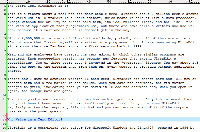 That's how I came to download version 16 this week. UltraEdit has change bars now. All new or changed text has a red marker in the left column. When you save the document, the red marker changes to green, indicating that you've saved it. Close the document and, when you open it again, the change bars are gone.
That's how I came to download version 16 this week. UltraEdit has change bars now. All new or changed text has a red marker in the left column. When you save the document, the red marker changes to green, indicating that you've saved it. Close the document and, when you open it again, the change bars are gone.
This is a good visual reminder that shows how much of your text hasn't yet been saved. Even though it hasn't been saved, the text isn't really at risk, though, because UltraEdit regularly writes the temporary file to disk and you can recover most of it if the computer crashes or the power goes out.
Why Write in a Text Editor?
For writers, the allure of a text editor is that you can't get hung up in spelling and formatting. There is a spell-check function, but it's manual. And formatting isn't possible because it's just plain text. You can worry about margins, columns, bold, italics, and the like later. When you're writing, you need to concentrate on writing. That's why I use UltraEdit to prepare much of the content for TechByter Worldwide.
The Main Audience
Ian Mead is a programmer and his primary audience for UltraEdit is programmers. Currently available for Windows and Linux, a Mac version is in the works. The editor contains many powerful tools for programmers, including the ability to create macros; syntax highlighting that helps programmers write good code; code folding that compresses or expands sections of code; the ability to convert files between Windows, Mac, and Linux/Unix format; project management; regular expressions for search-and-replace; a column-edit mode; the ability to edit files on remote machines via FTP; and the ability to have many files open simultaneously and to save the file arrangement in a "workspace".
Originally a 16-bit application, UltraEdit became a 32-bit application after version 6.20b. It continues to be a 32-bit application that runs well in a 64-bit environment.
Special Features
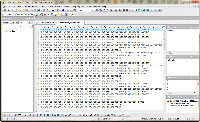 Fixed-length files are an abomination, but they continue to be used. They are human readable, but not human friendly. UltraEdit makes it possible to define column markings that help you keep track of the columns.
Fixed-length files are an abomination, but they continue to be used. They are human readable, but not human friendly. UltraEdit makes it possible to define column markings that help you keep track of the columns.
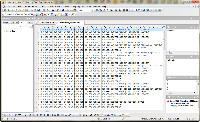 Better still, you can create any number of column definitions and save them in an XML file that you can share with your co-workers who use UltraEdit. This isn't a new feature, but it's one that I found in this version.
Better still, you can create any number of column definitions and save them in an XML file that you can share with your co-workers who use UltraEdit. This isn't a new feature, but it's one that I found in this version.
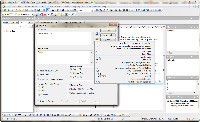 Regular expressions are powerful and UltraEdit has supported them for a long time, but the syntax is difficult to remember. UltraEdit has always had a good help file entry for regular expressions, but v16 adds the "regex builder", which is accessible in all Find/Replace dialogs. Use this feature long enough and you might come to really understand regular expressions.
Regular expressions are powerful and UltraEdit has supported them for a long time, but the syntax is difficult to remember. UltraEdit has always had a good help file entry for regular expressions, but v16 adds the "regex builder", which is accessible in all Find/Replace dialogs. Use this feature long enough and you might come to really understand regular expressions.
Version 16 has lots of other new features, but most of them are so esoteric that they'll make sense only to hard-core programmers. If you're one of those folks, don't miss the latest version of UltraEdit.
For a complete look at the new features, see What's New in UltraEdit 16 on the UltraEdit website.
 Bottom Line: UltraEdit. 5 Cats. In other words, the usual.
Bottom Line: UltraEdit. 5 Cats. In other words, the usual.
With every new version of UltraEdit, I think that Mead and company have produced the ultimate text editor, the programmer's tool that can never be improved upon. And a year or so later, Mead and company come up with a new and improved version that improves on perfection. If you're a writer who uses a text editor for writing, you don't need the new version. If you're a programmer or someone who works with data, get out your checkbook.
For more information, visit the UltraEdit website.
The Frauds Are Improving
Last Thursday, I received a message from Amazon to confirm my order. (But I don't have any open orders.) The message came to an obsolete office address. (I have never used that address for an Amazon purchase.) But someone who has recently placed an order with Amazon might just be tempted to click the link. That would be a mistake.
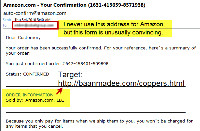 But not a fatal mistake. The link wouldn't take you to a site that would turn your computer into a zombie. In this case, it would take you only to a fake "Canadian" "pharmacy". If I know where the link goes, I must have stupidly clicked it, right?
But not a fatal mistake. The link wouldn't take you to a site that would turn your computer into a zombie. In this case, it would take you only to a fake "Canadian" "pharmacy". If I know where the link goes, I must have stupidly clicked it, right?
Wrong.
But first, let's consider the message. Amazon.com - Your Confirmation it said and it displayed a reasonable Amazon-like order number. The message claimed to be from auto-confirm@amazon.com, but you already know how easy it is to fake that.
Several fatal clues exist to reveal that the message is a fake:
- The order number in the body of the message doesn't match the order number on the subject line.
- I'm addressed as "Dear Customer". Amazon would know my name.
- Three words in the text should contain apostrophes (' or ’); instead, they contain the back-tick (`).
That's all there is. No egregious grammatical or spelling errors. And that makes this message dangerous. I've been warning for quite some time that the bad guys would eventually figure out how to create messages that look real.
That time has come.
Did I Click the Link?
 No, I did not click the link. Instead, I collected the link text from the message and handed it over to Sam Spade, a utility program that can transmit an HTTP request and then display the HTML that the site returns.
No, I did not click the link. Instead, I collected the link text from the message and handed it over to Sam Spade, a utility program that can transmit an HTTP request and then display the HTML that the site returns.
The first page was simply a redirector. It used a bit of JavaScript to send me to the payload.
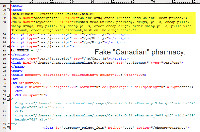 In this case, the payload was tame -- nothing more than a website for a "Canadian" "pharmacy" that is neither Canadian nor a pharmacy. But it could have been far worse. It might have been a link to a site that plants malware on the computer. If you land on one of these sites and you don't have a fully patched computer (and maybe even if you do) the site will load malware that could turn your computer into a spambot or a porn server, or it might just install a key logger that will send your banking information to people you would not want to have it.
In this case, the payload was tame -- nothing more than a website for a "Canadian" "pharmacy" that is neither Canadian nor a pharmacy. But it could have been far worse. It might have been a link to a site that plants malware on the computer. If you land on one of these sites and you don't have a fully patched computer (and maybe even if you do) the site will load malware that could turn your computer into a spambot or a porn server, or it might just install a key logger that will send your banking information to people you would not want to have it.
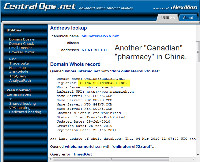 The next tool I used was the CentralOps website. I gave it the domain name of the "pharmacy" and I learned that it was registered in China. Examining a globe, I learned that China is not particularly close to Canada. It seems to me that the average Canadian pharmacist who wanted to put his business online would use a Canadian or US registrar.
The next tool I used was the CentralOps website. I gave it the domain name of the "pharmacy" and I learned that it was registered in China. Examining a globe, I learned that China is not particularly close to Canada. It seems to me that the average Canadian pharmacist who wanted to put his business online would use a Canadian or US registrar.
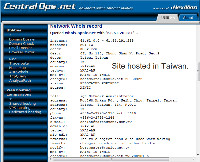 But let's play along. Let's say that a Canadian pharmacy really did register a domain with China Springboard Inc. Wouldn't you think that the Canadian Pharmacy would at least want to host its site on a Canadian or US server?
But let's play along. Let's say that a Canadian pharmacy really did register a domain with China Springboard Inc. Wouldn't you think that the Canadian Pharmacy would at least want to host its site on a Canadian or US server?
The site is actually hosted on a server that's located in Taiwan. Or at least that's what the registrar claims. Maybe the registrar is mistaken, so I asked CentralOps to trace the route from me back to the "Canadian" "pharmacy".
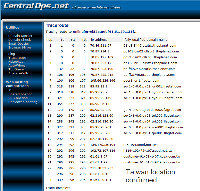 It is located in Taiwan (.tw).
It is located in Taiwan (.tw).
Would you want to do business with a Canadian pharmacy that is in Taiwan? Would you want to do business with someone who tricks you into visiting their website by sending a message that claims to come from Amazon.com?
I wouldn't.
But that's not the main point. The main point is that fake messages are becoming harder to spot. The crooks are getting better at what they do.
This is why it's important to treat every message you receive with a bit of skepticism.


 The author's image: It's that photo over at the right. This explains why TechByter Worldwide was never on television, doesn't it?
The author's image: It's that photo over at the right. This explains why TechByter Worldwide was never on television, doesn't it?
